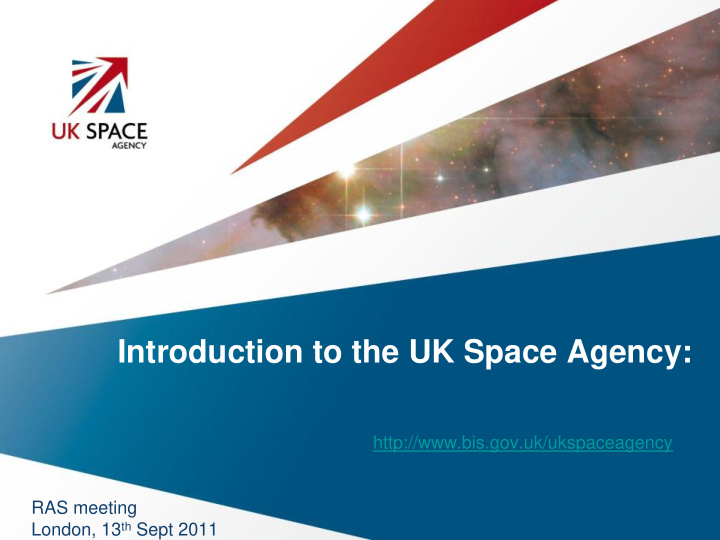



Introduction to the UK Space Agency: http://www.bis.gov.uk/ukspaceagency RAS meeting London, 13 th Sept 2011
Purpose of UK Space Agency • To meet national needs, the Agency is responsible for ensuring that the UK retains and grows a strategic capability in space-based systems, technologies, science and applications. • The UK Space Agency will therefore enable sustained economic growth, scientific excellence and societal benefits from the UK civil space sector.
Our strategy ‘To lead and sustain the growth of the UK Space Sector’
A solid foundation to build on…
The UK space sector has changed Formation of UK Space Agency Industry-led strategy to grow the sector over ten years (‘Space IGS’) Goal to win 10% of £400B market in 2030 Establishment of an ESA presence in the UK Creation of the International Space Innovation Centre at Harwell New businesses exploiting space …but where does science fit in ?
Government civil space expenditure (£270M in 2009/10)
Governance and Advice Strategic Strategic Advice Advice Co-chaired by Minister and Andy Green, Logica CEO and Chair of Space IGT Advice to Chief Advice to Chief Exec. Exec. Formal oversight Formal oversight Policy and Policy and Programme Programme Advice Advice EXTERNAL ADVICE EXECUTIVE CHAIN
Policy and Programme priorities • European • Telecoms and space policy navigation • Global • New applications partnerships for Government • Technology and business • Education, Skills & Outreach • ESA’s Cosmic Vision • Mars exploration for • science using Earth science , technology and observation techniques inspiration • Global Monitoring for • UK in a global framework Environment and Security (GMES)
Budgets and Planning • Detailed reviews of cost of ongoing and possible new projects in 2010/11 • Extensive work by SPAC and AurAC to assess priorities and shape programme • Agency overall programme budget for SR period announced in December 2009 – Broadly sufficient to cover existing commitments over the 4 year SR period – £773.5M resource + £76M capital = £850M total – No margin for 2012 ESA Ministerial commitments
What this does not allow 1. Funding for the KuaFu solar/terrestrial mission with China 2. Any UK instruments for ExoMars Trace Gas Orbiter 3. Funding for ESA ‘missions of opportunity’ such as SPICA 4. Funding for new bilateral science missions
What this does allow (1/2) 1. Continued operation of: Herschel, Planck, STEREO, Hinode, Swift, Rosetta and run out of SOHO 2. Completion, launch and operation of; LISA Pathfinder LTP, JWST MIRI, Bepi Colombo MIXS, GAIA 3. Adequate funding for ESA M1 and M2 4. ‘Keep-alive’ funding for ESA Large missions until situation becomes clearer 5. Assessment phase support for M3 candidate missions
What this does allow (2/2) 6. 2 PI and 2 Co-I instruments for ExoMars rover 7. Science team (Co-I) involvement in ExoMars Trace Gas Orbiter 8. Aurora national programme elements including current spin out programme; CREST 2 and science community & exploitation work 9. An annual cubesat technology demonstration mission – Hope to announce early next year 10.Adequate community support e.g. to COSPAR, Alpbach summer school, ESF-ESSC, SPAN and similar activities
A reminder of who does what Extensive coordination (‘dual key’ for grants; cross representation on advisory panels etc.) * Includes mission data systems such as GAIA DPAC
Technology - Existing National Programmes Basic R&D through to flight demonstrations and applications
National Space Technology Programme
Harwell and the wider UK space sector Agency partners (TSB, research International councils, Space MoD…) RAL Space: Innovation ESA Including Centre Ltd. existing facilities ESA Business Harwell Space EU space Incubator Cluster programme creating new space businesses Co-located universities and International industry Space ESA Centre Supporting and Agencies exploiting the campus • Applications environment • Climate Industry, Change universities and • Exploration research organisations
ESA at Harwell The establishment of ESA Harwell (opened in July 2009) was the consequence of an explicit political decision: • To anchor ESA in the UK • To anchor the UK in ESA
Our Vision for ESA Harwell 1. Home of ESA ‘Innovation and Applications Centre ’ working on telecoms, navigation and EO applications as well as IAP 2. Home of Climate Change Initiative programme 3. Home of space exploration facilities and competences not available elsewhere in ESA 4. Infrastructure and tools to promote innovation across ESA
In summary
Recommend
More recommend